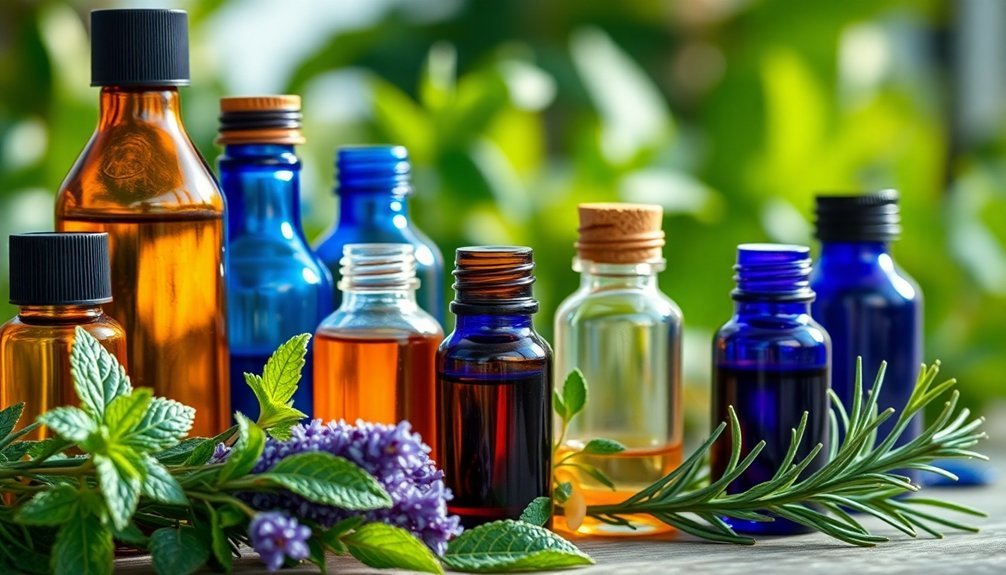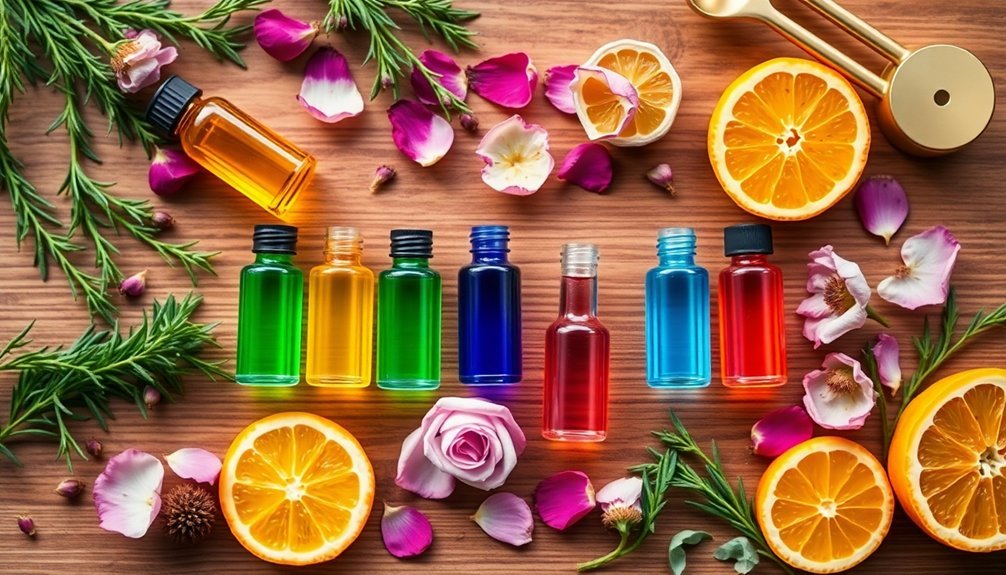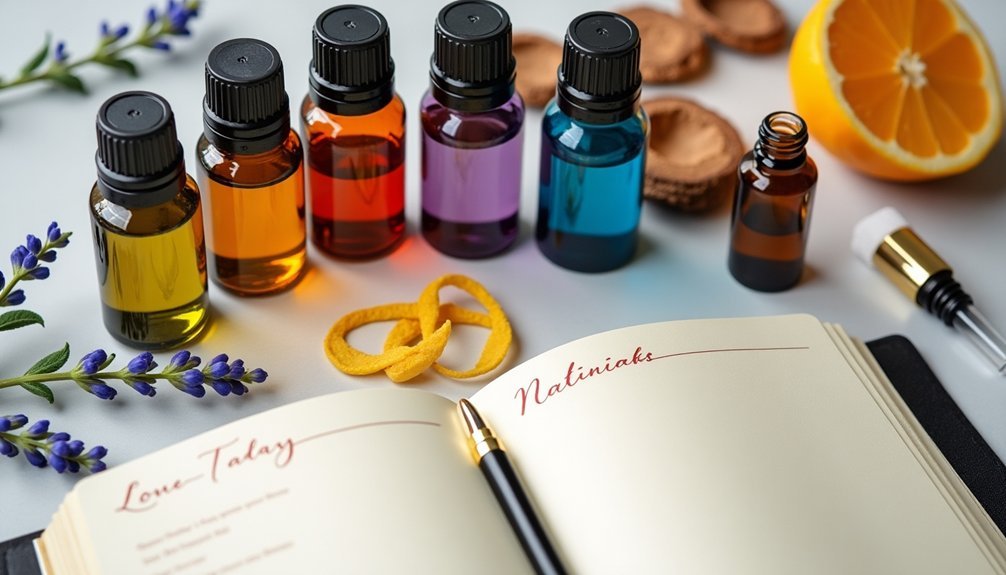To create the perfect oil perfume recipe, you'll need a balanced blend of all three fragrance notes. Start with bright top notes like bergamot or lemon (10-20%), add middle notes such as lavender or jasmine (30-50%), and finish with lasting base notes like sandalwood or vanilla (40-60%). Mix these with a carrier oil like jojoba or fractionated coconut oil for ideal wear. Understanding the art of proper ratios and combinations will elevate your custom scent to professional quality.
Understanding Essential Oil Notes and Their Roles

When creating the perfect oil perfume, understanding the three distinct note categories is essential to achieving a well-balanced fragrance.
You'll find that top notes provide the initial burst of fragrance, evaporating within 30 minutes and making up 10-20% of your blend. These light, uplifting scents include citrus oils like bergamot and lemon. Consider using mint oils in trace amounts due to their powerful scent intensity.
Middle notes form the heart of your perfume, lasting 2-4 hours and comprising 30-50% of the blend. They're full-bodied and complex, featuring oils like lavender and jasmine.
Base notes are your perfume's foundation, making up 40-60% of the blend and lasting over a day. These deep, woody scents like cedarwood and sandalwood act as fixatives, giving your perfume longevity and grounding the overall fragrance.
Popular Scent Combinations for Different Moods
Armed with your understanding of fragrance notes, you can now explore specific oil combinations that target different emotional states and purposes.
For relaxation, try blending lavender with frankincense and cedarwood, or combine chamomile with clary sage for deep calming effects.
When you need an energy boost, mix lemongrass, ginger, and peppermint for an invigorating aroma.
Create romantic moments by combining sandalwood with rose and jasmine, or blend ylang ylang with lavender and lemon.
If you're seeking mental clarity, pair cedarwood with eucalyptus and lemon, or try rosemary with black spruce and peppermint.
Each combination serves a unique purpose, letting you customize your perfume to match your desired mood or emotional state. Starting with small quantities for precision allows you to perfect your blend through careful experimentation.
The Art of Blending Ratios and Proportions

The science of creating a mesmerizing perfume lies in mastering the delicate balance of fragrance notes through proper ratios and proportions. You'll want to follow the trusted 3:5:2 ratio or the 30/50/20 rule when crafting your blend. These proportions guarantee your perfume develops a complex character that unfolds beautifully over time. Following the principle of synergistic blending, choosing oils that complement each other will enhance the overall fragrance profile.
| Notes | Ratio Parts | Example Oils |
|---|---|---|
| Top | 3 parts | Bergamot, Peppermint |
| Middle | 5 parts | Lavender, Geranium |
| Base | 2 parts | Sandalwood, Patchouli |
| Total | 10 parts | Multiple combinations |
Start with small batches to perfect your blend before scaling up. You can adjust these ratios slightly based on your preferences, but remember to maintain the general proportion structure to achieve a well-balanced fragrance that shifts smoothly from first spritz to final dry-down.
Carrier Oil Selection for Long-Lasting Fragrance
Selecting the right carrier oil forms the foundation of a long-lasting perfume that both delights and nourishes your skin.
You'll find jojoba oil and fractionated coconut oil are top choices, as they excel at locking in fragrance while remaining completely neutral in scent.
If you have sensitive skin, opt for hypoallergenic options like jojoba or sweet almond oil.
For dry skin, you'll benefit from richer carriers like argan or avocado oil, which provide intense moisturization while maintaining scent longevity.
Consider absorption rates when making your selection.
Fractionated coconut oil and grapeseed oil sink in quickly, making them perfect for daily wear.
Whatever you choose, verify it matches your skin type and fragrance goals – the right carrier oil can make the difference between a fleeting scent and a lasting signature perfume.
Creating Your Signature Scent: Step-by-Step Process

Creating your perfect signature scent begins with understanding the delicate interplay between fragrance notes.
Start by selecting your base notes, which will provide lasting power to your blend – consider warm options like musk, vanilla, or sandalwood.
Next, build your heart notes using florals or spices that complement your base.
Finally, add bright top notes like citrus or herbs to create that initial impression.
Mix your oils gradually, starting with a 5% dilution ratio in your carrier oil.
Keep detailed notes of each combination you try, and don't rush the process.
Let your blends mature for 24-48 hours before making adjustments.
Remember to conduct patch tests to ascertain skin safety.
Store your creation in a dark glass bottle in a cool place to preserve its quality and allow the scent to develop fully.
Frequently Asked Questions
How Long Will My Homemade Oil Perfume Last Before the Scent Fades?
Your homemade oil perfume will last 3-6 months if you've stored it properly in a dark bottle, kept it cool, and used quality ingredients. The scent can stay fresh on your skin for 4-8 hours.
Can I Mix Synthetic Fragrances With Essential Oils in My Perfume?
Yes, you can mix synthetic fragrances with essential oils. You'll get better scent throw and longevity, plus more creative options. Just guarantee you're using high-quality synthetic oils from reputable sources for safety.
Why Does My Perfume Smell Different on My Skin Than Bottle?
Your skin's unique chemistry, temperature, and pH level interact with fragrance molecules, changing how they smell. Your natural oils, hormones, and even diet can make perfume scent different on your skin versus the bottle.
Should I Refrigerate My Oil Perfume to Make It Last Longer?
You don't need to refrigerate oil perfumes. Keep them in a cool, dark place at room temperature (65-85°F). Refrigeration can cause condensation and potentially alter the fragrance's composition. Original packaging works best.
Can Certain Essential Oil Combinations Trigger Headaches or Sensitivities?
Yes, you'll find that strong combinations or undiluted essential oils can trigger headaches and sensitivities. It's best to dilute oils properly, perform patch tests, and start with small amounts to avoid reactions.
In Summary
You're now equipped to create your own signature oil perfume by combining top, middle, and base notes in balanced proportions. Don't forget to test your blends before committing to larger batches, and always dilute your essential oils in a quality carrier oil. Whether you're aiming for a fresh daytime scent or a sultry evening fragrance, you've got the knowledge to craft the perfect oil perfume that's uniquely yours.





Leave a Reply